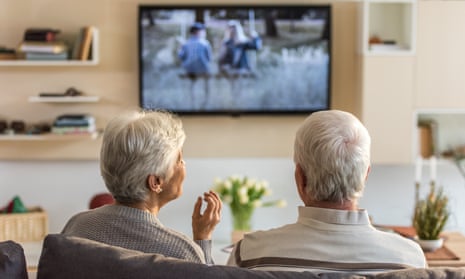If you are 61 and taking a break from watching something on BBC1 to read this, you can congratulate yourself on being entirely average. That is, the average age of a BBC1 viewer, according to the latest estimates published by the BBC Trust (in its death throes – the arms-length regulator will be replaced by hands-free Ofcom next week). On BBC2, it is 62. In 2014, the Trust reported that average ages were 59 and 60 respectively.
It’s not that young people aren’t watching BBC content. The report also reveals that last year the broadcaster reached 91% of 16 to 34-year-olds in one way or other. But with the proportion of those young people watching BBC TV dropping now to 66%, greying audiences are causing yet more demographic consternation in broadcasting headquarters.
According to recent research by Enders Analysis, ITV’s average viewer is now 60; Channel 5’s is 58 and Channel 4’s is 55. Even at E4, birthplace of such yoof-targeting shows as Made in Chelsea and Hollyoaks, the average age is 42.
The reason, of course, is simple: the internet, where the statistical trends are upended. Online, 59% of young people use the BBC’s services each week, compared with 52% of all adults. But as the report states: “Online take-up does not yet compensate for falling broadcast reach”. Moreover, they are watching less; over-55s spend 25 hours a week with the BBC; 16 to 34-year-olds just 11 hours. That gap has always existed, but it’s growing.
“This is a problem felt by all broadcasters,” says Robin Parker, features editor at Broadcast magazine. A big test for the BBC, he adds, will be the first sign of any shift in audience figures after the move of BBC Three to an online-only model. As YouTube and Facebook divert younger eyes, “I think the BBC will always have an issue of how it presents material in a way that’s not trying to be too cool but not seen as stuffy.”
What we don’t know is exactly how many of the same young people are watching TV elsewhere. Streaming services such as Netflix and Amazon Prime make big claims but are not obliged to issue audited viewing figures. “There is a lot of overclaiming at the moment,” says Margo Swadley, a former BBC executive and now the managing director of UK TV and video measurement at Kantar Media. “It’s impossible to do like-for-like comparisons.” Why does it even matter that the ages of viewers are shifting? “Because it has an impact on the whole ecosystem,” Swadley replies. “The motivator for talent is a good audience.”
In one of her last speeches as chair of the BBC Trust earlier this month, Rona Fairhead told the Oxford Media Convention that the BBC needed to better serve young people. Referring to another popular titan that failed to keep pace with digital change, she said that the BBC needed to “avoid its own Kodak moment”. As the instamatic channels continue to adjust to the new digital era, it’s a warning that could apply beyond Broadcasting House.

Comments (…)
Sign in or create your Guardian account to join the discussion